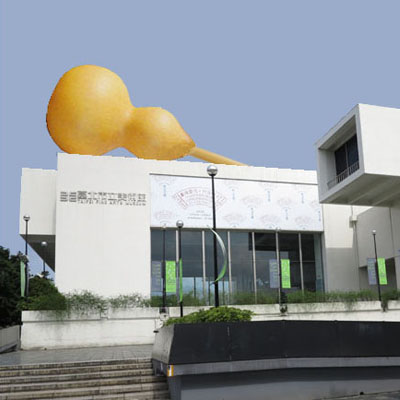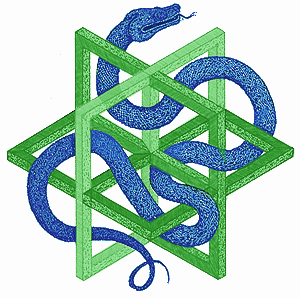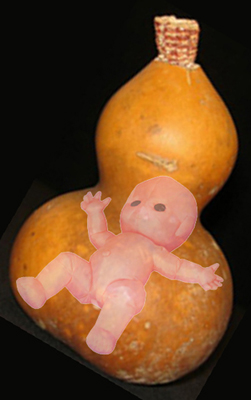idea : B Monster


idea : C automatic device tfam







 壺中天
壺中天  [mov]
[mov]
台灣/邁向葫蘆的年代「葫蘆博物館」 2012-09-20 17:33:02 策展人港千尋
《2012台北雙年展》以透過在亞洲的觀點,反映現代性歷史的諸多問題與過程;在談到歷史,不可能忽略與世界起源有關的各種論述,如開天闢地的神話,或為了可以創造新世界的大破壞。日本策展人港千尋提出以「葫蘆」作為可能觀看或建構歷史的模型,自古以來,葫蘆與人類生活演進的歷程有著密切的關係,如盛裝的器皿功能、共鳴發聲器、繪畫雕刻以及伴隨著的許多神話傳說與象徵,策展人港千尋尤其強調葫蘆用於掌握水與空氣的流動性,藉以思考當下的核子能源使用,尤其以他自己生長於日本的背景,在經歷311大地震後,對於核能產生過程的矛盾,提出一份對未來的想像。
葫蘆,世界最古老的作物之一,容易種植採收,自遠古以來,在世界各地等皆有葫蘆的生長足跡,它被取用為盤子、湯匙或是盛裝液體的容器;同時因為它的形狀如天然的共鳴器,亦常被作為樂器使用。除了作為生活功能的「工具」使用,在神話傳說中,它的種子代表富饒的意味,形體本身作為天災侵襲的逃生工具,收拾妖怪或占卜吉凶的功能等。
「葫蘆」與人類文化的進程,因為它用於控制液體與空氣這兩種流動體,得以隨著人類遷徙至遠方,因為跨越陸地和水體的遷徙若沒有裝水的容器是無法達成的;而在中文的象形文字中,葫蘆最早的形狀相當於今日的「自由」二字,其中「由」一字說明將葫蘆中的內容物釋放出來之意。因此,若是沒有流動性,就沒有自由,而沒有葫蘆,就沒有流動性。
「葫蘆」做為承載流動性能源的「容器」,思考當下的「核子時代」,核電廠反應爐彷彿一個矛盾、違反自然法則的大容器,它產出巨大的能量必須被釋放,但因為帶有放射性毒害,則必須將其密封,以免造成大範圍的全球性污染,這情況在日本福島核災事件後更顯出其中矛盾。在此刻,於台北雙年展提出「葫蘆」或許是在一個超級高科技災害之後的低科技文化模範,須開始著眼於風力或水力等無須密閉卻持續作用的替代能源。
因此,「葫蘆博物館」的想法是在建立一個容納(思維的)流動性及自由的博物館,它會是一間活的博物館,收集、保存並交換著容器的概念,以及我們身處社會的內容及精神。尤其,台北具有結合歷史背景的心理地理學形式,台北市西北方的士林區有座過去被稱為「葫蘆島」(今社子島)的島嶼,現今的街名、機構名等仍保留這項地理特性;而台北雙年展出地點「台北市立美術館」地理位置則落在這座古老的葫蘆島之口。
「葫蘆博物館」在雙年展將呈現「第一屆葫蘆收藏」,透過神話、文學、圖畫和攝影等,一窺葫蘆的世界史。作品內容包含台灣藝術家張婷雅以裡外透視的觀點,繪製水印木刻版畫〈葫境〉系列;台灣潛心致力於匏雕藝術,鑽研葫蘆雕刻技法的藝術家龔一舫作品;竹藝師徐暋盛編製的大型葫蘆造型裝置,預計展於美術館三樓露台;日本電腦繪圖師原田大三郎,以影片動畫呈現具有容器-容量的建築形式;在博物館展區的入口,則以高橋士郎特殊的充氣技術(BABOT)設計製造出高約2.8公尺的〈大葫蘆〉,象徵這個時代的流動性與自由。
計畫由葫蘆博物館發行的《葫蘆雜誌》是一本包含藝術、設計、建築等多樣化議題的線上雜誌,其中的葫蘆論壇,造訪者能觀看有關葫蘆的記憶的影音資料,內容將邀請許多不同講者分享他們的葫蘆故事,並且留存於美術館的資料庫。最後,葫蘆商店展示著許多不同種類的創作,以原創性商品表現出流動的概念。
葫蘆博物館 呈現人類文明演進
葫蘆的外型不起眼,卻和常民生活習習相關,葫蘆在人類文明扮演什麼角色?答案在「二○一二台北雙年展」揭曉。廿九日開幕的台北雙年展,今年主題「現代怪獸/想像的死而復生」,由德國的法蘭克(Anselm Franke)擔任總策展。在主題之外,另有六個「微型博物館」計畫,由不同策展人訂立相關主題,日本策展人港千尋策畫的「葫蘆博物館」就是其中之一。
「台北雙年展」是歷年規模最大的雙年展,「現代怪獸/想像的死而復生」有國內外四十七位藝術家參展,在北美館之外,士林紙場也特闢展區。六個微型博物館計畫定為「葫蘆」、「韻律」、「『前』紀念」、「歷史與怪獸」、「基底無意識」、「跨越」,穿插在北美館展場與士林紙場展場中。
港千尋策畫的「葫蘆博物館」呈現葫蘆與人類文明之間的關係,「遠古與其稱之為石器時代,我更想稱它是『葫蘆時代』。」
港千尋表示,葫蘆是最古老的作物之一,數萬年來在非洲、歐亞大陸、美洲、太平洋諸島都見生長,可用來盛裝水酒當器皿,也是天然的樂器,在繪畫、文學、攝影均有紀錄。中國、日本的傳說故事裡,葫蘆象徵富饒,也是伏魔收妖的法器,或懸壺濟世的法寶,日本則傳說葫蘆是鎮伏引發地震的鯰魚精的神器。
「跨越陸地的遷徙,如果沒有裝水的容器是無法達成的,我想像史前時代人類的遷徙,造就葫蘆家族令人驚豔的多樣性,我們是不折不扣的葫蘆之子。」
港千尋邀請張婷雅、原田大三郎、龔一舫等台日本藝術家共五人參展。張婷雅的水印木刻「葫境」系列,想像葫蘆神祕的內在空間。龔一舫長年致力匏雕藝術、鑽研葫蘆雕刻技法,這次展出他收藏的百年葫蘆民藝。此外,日本藝術家高橋士郎製作二.八公尺高的充氣《大葫蘆》,以葫蘆象徵流動性與自由。
葫蘆是世界上最古老的作物之一,人類日常生活中取用它當作食物、裝水、器皿、樂器,而在神話故事中葫蘆更是具有神力,可以拿來裝取丹藥、收妖降魔,日本傳說故事中記載,水底深處潛藏一種鯰魚精妖怪,當鯰魚精一游出水面,就會引發強烈地震,而要鎮壓這隻怪獸便須依靠法器葫蘆。
日本策展人港千尋(Chihiro Minato)規劃了此「葫蘆博物館」,從歷史神話故事、人類文明演進回顧葫蘆的功用與神秘性,港千尋說:「人類有石器時代、工業時代,到近日的核能時代,但人類生活始終脫離不了與葫蘆的關係,因此我更想以『葫蘆時代』來稱人類的歷史。」又因為葫蘆的裝水功能,讓人類得以遷徙跨越陸地邊境,因此人類都可說是「葫蘆之子」。港千尋透過葫蘆的多樣性、承載流動物質的容器特性,反思「核能時代」下,核電廠反應爐作為一個違反自然的巨型容器,其所釋放的毒性物質,對人類與環境造成的危害。
The gourd has been used as a container across the world since ancient times. Grown in Africa, Eurasia, Austronesia, and America for more than ten thousand years, it is one of the world’s oldest cultivated plants. Easy to grow and cut, it was sometimes used as a dish, spoon, or a container for water and wine. In China and Japan, the seeds kept in the gourd were believed to be fertile, just as the gourd is itself a symbol of fertility and fluidity. In the Chinese myth of Genesis, it is said that a man and woman survived the Great Flood by using a large gourd as a boat. In eastern Taiwan there are villages where local shamans use the gourd bottle for divination. The first form of the Chinese ideogram for the gourd is found today in the word for “liberty”—for there is no liberty without fluidity and, it seems, no fluidity without the gourd.
Another use of the gourd, which may be as old as that of the container, is as a musical instrument. Its natural shape is an ideal resonator and has been used to make rattles, whistles, and many kinds of drums. Ancient history is often conceived in terms of such things as stone tools. The “Stone Age” is, I think, a particularly modern vision with a very limited perspective, because we do not know whether stone was actually the primary tool of this era. There must have been many more tools that were more important.
For this reason, I would prefer to call it the “Gourd Age.” Migration over land and water would not have been possible without a water container. If the amazing diversity of the gourd family is the result of human migration, then the gourd is one of those things that have sustained our long life on this planet while leaving very little trace of itself. We have shaped gourds and have been shaped by them. We are literally the children of the gourd.
On the question of containers, it is also interesting to reconsider the “Atomic Age” after the great earthquake in Japan.
The Fukushima nuclear disaster revealed not only the limit of our capacity to control nuclear energy but also its paradox: while the reactor generates immense energy, this energy must be totally contained. The reactor liberates the energy without fluidity, since fluidity would release dangerous radioactivity.
The vast contamination and planet-wide pollution following the Fukushima disaster illustrate this paradox. The gourd could be a model for the low-tech culture that will follow high-tech disasters. We have begun to turn our attention to alternative sources of energy from wind and from water—resources that flow freely. If the phenomenon of life is in fact this very flow, then the gourd is one of the oldest models of fluidity. The Hawaiian gourd, for example, symbolizes ocean winds and is also used as a musical instrument for Hawaiian dance.
We would like to offer this mini-museum as a container for (thinking) fluidity and liberty. The Museum of Gourd is a living museum that collects, keeps, and exchanges ideas about containers and the contents of our societies and minds. Some cities have
their psycho-geographical form incorporated into their historical setting—Taipei being one of these cities. In Shilin, the northwestern part of the city, there was once an island called Gourd Island, and we still find its form and its name on one of the streets. The Taipei Fine Arts Museum is located at the mouth of the ancient Gourd Island.
The Museum of Gourd will be composed of a number of sections. One will display the first edition of the Gourd Collection. The world history of the gourd will be traced through mythology, literature, drawing, and photography. The Taiwanese artist Chang Ting-Ya will draw the history through her inside-outside vision. Shiro Takahashi will make a “Big Gourd” with his BABOT technology, to symbolize the fluidity and liberty of our time. Daizaburo Harada, a leading Japanese computer graphic artist, will visualize the form of container-contents architecture.
In addition, Gourd Magazine will be an online magazine published by The Museum of Gourd. It will cover a wide range of topics such as art, design, architecture, and more. Many will be invited to share their gourd stories, which will be archived in the museum.
Finally, the Gourd Shop will sell original products that symbolize our philosophy of fluidity. (Chihiro Minato)
港千尋のキュレーションによる「The Museum of Gourd」は、容器や楽器として使用されてきた「ひょうたん」をテーマにした博物館。ひょうたんは、人間の長い歴史の中で、お皿や匙、水やワインなどを入れるものとして愛用されただけでなく、その口から液体が流れ出る様が「由」という漢字の成り立ちであるように、「自由」の象徴であるとも考えられてきた。しかし、その一方で、現代社会の巨大なひょうたんとも言える原子炉は、大震災において多くの人々の自由を奪い取ってしまった。「The Museum of Gourd」は、”思考の流動性と自由のための容器”として、ビエンナーレを訪れる多くの人に、様々な容器についての意見や考えを交わすことのできる場所を提供する。